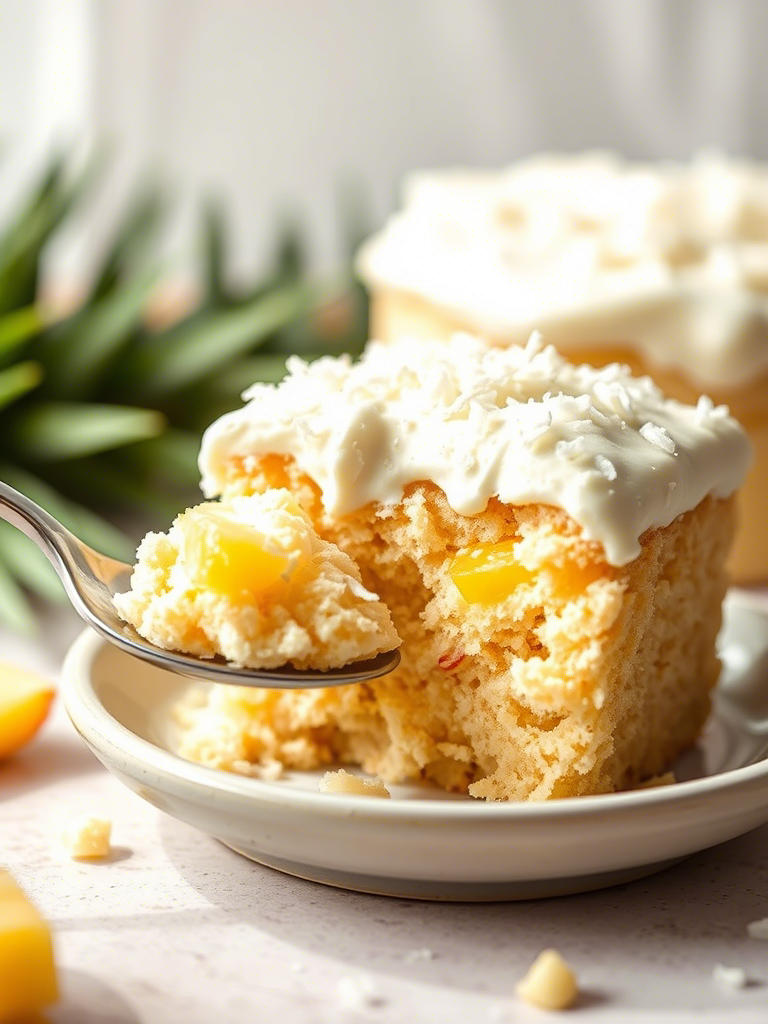If you’ve ever dreamt of blending tropical flavors into a cake that’s both luscious and airy, the Pineapple Coconut Dream Cake deserves your full attention. This dessert isn’t just a cake — it’s an experience, a bite that transports you to sun-soaked beaches and balmy breezes. Professionals in the culinary field often seek that elusive balance of texture, flavor, and presentation. This cake nails it by masterfully combining the acidity and sweetness of pineapple with the creamy, nutty depth of coconut.
Why am I bringing this up? Because while many recipes out there toss these ingredients together, few understand the nuances that turn a good cake into a dream cake. This article dives deep into the chemistry of the ingredients, baking techniques, and professional tricks to elevate your Pineapple Coconut Dream Cake beyond the ordinary.
The Tropical Flavor Symphony: Why Pineapple and Coconut Work
Pineapple is more than just a sweet fruit. Its natural acidity cuts through richness and balances sweetness, creating a lively taste profile. Coconut, especially in forms like coconut milk or shredded coconut, adds fat and texture. The interplay between these two ingredients isn’t happenstance; it’s backed by culinary science.
A 2018 study from the Journal of Food Science highlights how tropical fruits high in citric acid like pineapple help enhance the perception of sweetness without additional sugar. This is crucial in professional baking where sugar levels impact structure, moisture retention, and mouthfeel. Coconut’s fat content, particularly from coconut cream or milk, contributes to moistness and richness without heavy dairy fats, which can sometimes weigh down the cake.
Many traditional cakes rely heavily on butter or cream, but swapping some or all of that for coconut products can produce a lighter yet richer crumb. This approach resonates with the growing trend toward dairy alternatives and evokes a subtler tropical vibe that traditional cream-based cakes often miss.
The Cake Base: Techniques for the Perfect Moist Yet Stable Crumb
A moist cake is the holy grail, but achieving that perfect moistness while maintaining a stable crumb can be tricky. Professionals often look beyond just adding fruit juices or purees. Instead, consider the function of each ingredient.
Flour choice and treatment matters a lot. Cake flour, with its lower protein, creates a tender crumb, but too much softness can cause collapse, especially with added moisture from pineapple. Many bakers prefer a blend of cake and pastry flour or even the strategic addition of cornstarch to temper gluten development.
Eggs, beyond binding, contribute to structure. Separating eggs and whipping whites to a soft peak before folding them gently into the batter can add airiness, offsetting the density introduced by the shredded coconut and pineapple.
Then comes the pineapple itself. Fresh pineapple brings freshness but can also add excess water. Canned crushed pineapple in juice or syrup is more predictable but varies by brand and batch. Professionals often drain canned pineapple but reserve the juice to adjust liquid ratios, ensuring moisture without sogginess.

Coconut in Its Many Forms: Milk, Cream, and Shredded
Coconut isn’t a one-note player here. It brings complexity through different textures and fats depending on the form used.
- Coconut milk: Adds creaminess and moisture. Use full-fat coconut milk for richness; light versions won’t provide the same mouthfeel.
- Coconut cream: Higher fat content, great for frostings or fillings. Also useful for enriching the batter if you want an ultra-moist texture.
- Shredded coconut: Provides chew and visual interest. Toasting shredded coconut before folding it in enhances its nutty aroma and adds textural contrast.
- Desiccated coconut: Dryer, finer than shredded, best used in frostings or as a garnish, but can be blended into the batter for subtle texture.
Balancing these forms within the cake batter, filling, and frosting is a subtle art. Too much shredded coconut in the batter risks dryness and heaviness. Incorporating coconut milk in the wet ingredients while folding in a modest amount of toasted shredded coconut strikes the right chord.
Frosting and Filling: Layering Flavors and Textures
A cake’s frosting is more than decoration; it can be a flavor amplifier. For Pineapple Coconut Dream Cake, cream cheese frosting enriched with coconut cream is a classic pairing. The tanginess of cream cheese cuts through the sweetness and the fat from coconut cream smooths it out. This combination also complements pineapple’s acidity beautifully.
Another emerging trend among pros is the use of stabilized whipped coconut cream — a dairy-free alternative that still delivers volume and richness. Stabilizing agents like agar agar or gelatin prevent the coconut cream from weeping, a common issue with non-dairy whipped toppings.
Filling-wise, pineapple curd or a compote with a hint of rum or vanilla bean can introduce layers of complexity. The filling shouldn’t overpower but instead marry well with the cake crumb and frosting.
Common Challenges and Pro Tips for Success
One of the biggest challenges with this cake is moisture management. Pineapple and coconut both bring water, so you need to adjust other liquids accordingly. Use a kitchen scale for precise measurements — eyeballing just won’t cut it at this level.
Another frequent issue is texture. Adding too much shredded coconut without balancing with sufficient liquid can lead to a dry, crumbly cake. Toast shredded coconut just before adding for flavor and to reduce excess moisture.
Overmixing the batter? Don’t. It activates gluten too much, making the crumb tough. Fold ingredients gently and stop once combined.
Bake at a slightly lower temperature than standard — 325°F (160°C) instead of 350°F (175°C) — to ensure even cooking without drying the cake. Use an oven thermometer to verify, as many ovens run hotter than the dial suggests.

Addressing Misconceptions and Trends
Some say Pineapple Coconut Dream Cake is “too sweet” or “too tropical” for mainstream appeal. That’s mostly a misconception rooted in poor recipes or lack of balance. When done right, the cake should taste fresh, balanced, and layered with complexity.
Another myth: coconut always means heaviness. In reality, using coconut milk or cream selectively and incorporating whipped egg whites or meringue can create a light and airy texture.
Trends in professional baking are leaning toward incorporating global flavors with nuanced techniques. Tropical cakes like this one are perfect for that. The recent surge in demand for plant-based alternatives also makes the coconut-based cream cheese frosting or coconut cream whipped topping very relevant.
Real-World Examples from Top Pastry Chefs
Pastry chefs like Christina Tosi have reimagined tropical cakes by integrating toasted coconut and pineapple compote with light mousses. Their approach shows that balance isn’t just about ingredients, but layering textures and temperatures.
In culinary competitions, judges often praise cakes that showcase freshness alongside technical precision — Pineapple Coconut Dream Cake, with its bright flavor and moist crumb, fits that mold when done right.
Summary and Takeaway Tips for Professionals
Pineapple Coconut Dream Cake is not just a recipe; it’s a delicate balance of acidity, sweetness, fat, and texture. Managing moisture, selecting the right flours, balancing pineapple’s juice, and layering coconut in various forms are key to success.
For pros aiming to impress:
- Use a blend of cake and pastry flour.
- Drain canned pineapple but reserve juice for liquid adjustment.
- Toast shredded coconut to enhance flavor and texture.
- Fold egg whites gently for airiness.
- Bake at a slightly reduced temperature.
- Experiment with cream cheese-coconut cream frosting or stabilized coconut whipped cream.
This cake embodies the tropical dream in every bite. When executed with care and technique, it becomes an unforgettable centerpiece in any dessert lineup. You’re not just baking a cake; you’re crafting a taste of paradise that’s scientifically balanced and artistically beautiful.
If you want to nail that tropical vibe and technical finesse, this cake is your next baking frontier. Give it a whirl and watch how your guests or clients get hooked.
FAQs
What makes Pineapple Coconut Dream Cake different from other tropical cakes?
It balances pineapple’s acidity with coconut’s creaminess for a moist, layered flavor experience.
Can I use fresh pineapple instead of canned?
Yes, but fresh pineapple needs to be drained well to avoid excess moisture.
Why use a blend of cake and pastry flour?
To create a tender yet stable crumb that holds moisture without collapsing.
How does coconut milk affect the cake texture?
It adds richness and moistness without the heaviness of dairy fats.
Is toasting shredded coconut necessary?
Toasting enhances flavor and prevents sogginess in the cake.
Can this cake be made dairy-free?
Yes, by using coconut cream and stabilized whipped coconut instead of dairy-based frostings.
What’s the best way to prevent the cake from drying out?
Bake at a lower temperature (around 325°F) and adjust liquids carefully.
How should I handle the pineapple juice in the recipe?
Drain the pineapple but use the juice to adjust batter moisture precisely.
Why fold in whipped egg whites?
To add airiness and lighten the dense texture from coconut and pineapple.
What frosting pairs best with this cake?
Cream cheese frosting enriched with coconut cream or stabilized whipped coconut cream.
Is this cake suitable for vegan diets?
With some ingredient swaps (egg replacers, dairy-free frosting), yes it can be adapted.
How to avoid the cake being too sweet or too tropical?
Balance acidity and sweetness carefully and layer flavors, avoiding overpowering any one element.

Mariana is a passionate home cook who creates delicious, easy-to-follow recipes for busy people. From energizing breakfasts to satisfying dinners and indulgent desserts, her dishes are designed to fuel both your body and hustle.
When she’s not in the kitchen, she’s exploring new flavors and dreaming up her next recipe to share with the Foodie Hustle community.

